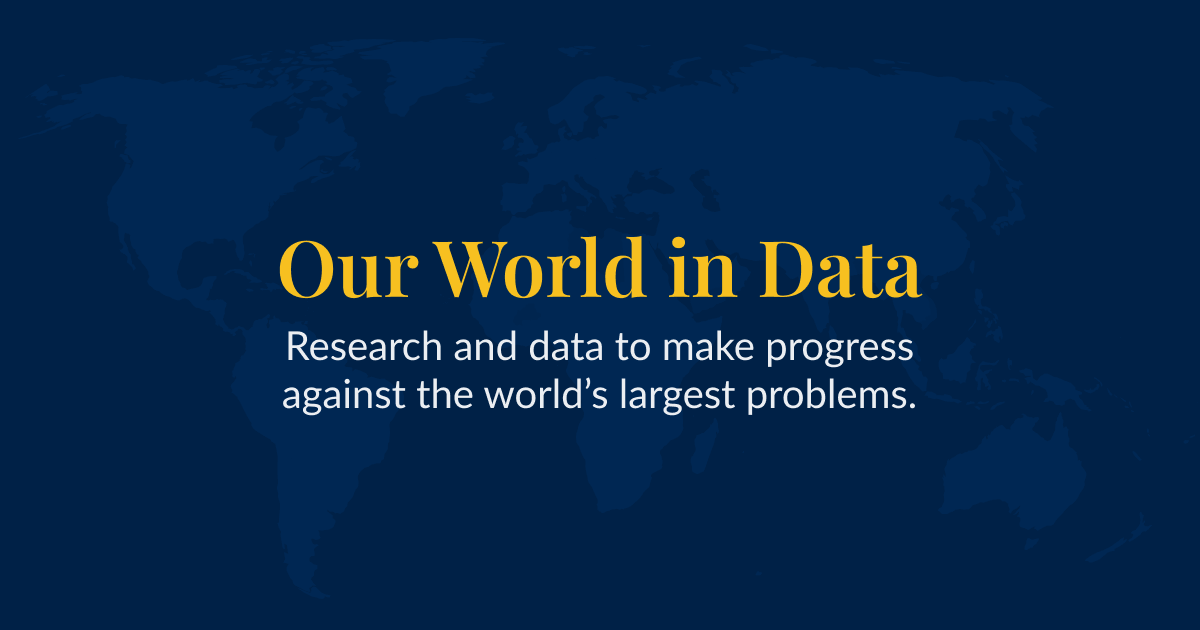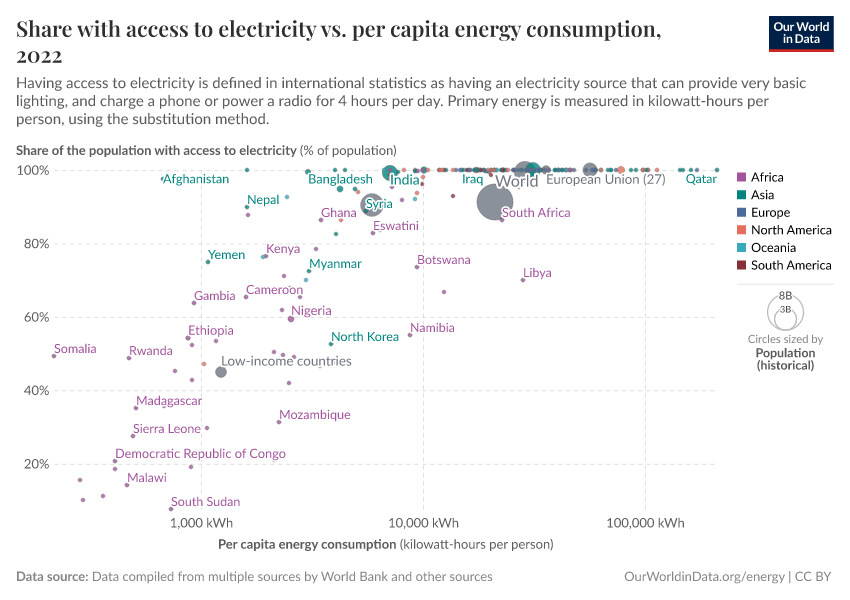Share of the population with access to electricity

What you should know about this indicator
- Access to electricity improves people's living conditions in many ways. Light at night makes it possible to get together after sunset; mobile phones allow us to stay in touch with those far away; refrigeration reduces food waste; and household appliances free up time from chores.
- This data captures whether people have access to the most basic electricity supply — just enough to provide basic lighting and charge a phone or power a radio for 4 hours per day.
- It shows that, especially in several African countries, a large share of the population lacks the benefits of basic electricity.
- Universal access to electricity by 2030 is one of the United Nations Sustainable Development Goals.
- This data comes from the World Bank's World Development Indicators. Estimates are based on national household surveys, census data, and reports from energy providers or government agencies. Where data is missing, values are estimated by the source using a model based on trends across countries, regions, and time. Countries classified as “developed” by the United Nations are assumed to have universal access.
- To learn more, read our article: Definitions: access to electricity.
Related research and writing
What you should know about this indicator
- Access to electricity improves people's living conditions in many ways. Light at night makes it possible to get together after sunset; mobile phones allow us to stay in touch with those far away; refrigeration reduces food waste; and household appliances free up time from chores.
- This data captures whether people have access to the most basic electricity supply — just enough to provide basic lighting and charge a phone or power a radio for 4 hours per day.
- It shows that, especially in several African countries, a large share of the population lacks the benefits of basic electricity.
- Universal access to electricity by 2030 is one of the United Nations Sustainable Development Goals.
- This data comes from the World Bank's World Development Indicators. Estimates are based on national household surveys, census data, and reports from energy providers or government agencies. Where data is missing, values are estimated by the source using a model based on trends across countries, regions, and time. Countries classified as “developed” by the United Nations are assumed to have universal access.
- To learn more, read our article: Definitions: access to electricity.
Sources and processing
This data is based on the following sources
How we process data at Our World in Data
All data and visualizations on Our World in Data rely on data sourced from one or several original data providers. Preparing this original data involves several processing steps. Depending on the data, this can include standardizing country names and world region definitions, converting units, calculating derived indicators such as per capita measures, as well as adding or adapting metadata such as the name or the description given to an indicator.
At the link below you can find a detailed description of the structure of our data pipeline, including links to all the code used to prepare data across Our World in Data.
Reuse this work
- All data produced by third-party providers and made available by Our World in Data are subject to the license terms from the original providers. Our work would not be possible without the data providers we rely on, so we ask you to always cite them appropriately (see below). This is crucial to allow data providers to continue doing their work, enhancing, maintaining and updating valuable data.
- All data, visualizations, and code produced by Our World in Data are completely open access under the Creative Commons BY license. You have the permission to use, distribute, and reproduce these in any medium, provided the source and authors are credited.
Citations
How to cite this page
To cite this page overall, including any descriptions, FAQs or explanations of the data authored by Our World in Data, please use the following citation:
“Data Page: Share of the population with access to electricity”, part of the following publication: Hannah Ritchie, Pablo Rosado, and Max Roser (2019) - “Access to Energy”. Data adapted from SDG 7.1.1 Electrification Dataset, World Bank, via World Bank. Retrieved from https://archive.ourworldindata.org/20251220-152415/grapher/share-of-the-population-with-access-to-electricity.html [online resource] (archived on December 20, 2025).How to cite this data
In-line citationIf you have limited space (e.g. in data visualizations), you can use this abbreviated in-line citation:
Data compiled from multiple sources by World Bank – with minor processing by Our World in DataFull citation
Data compiled from multiple sources by World Bank – with minor processing by Our World in Data. “Share of the population with access to electricity – World Bank” [dataset]. SDG 7.1.1 Electrification Dataset, World Bank, via World Bank, “World Development Indicators 122” [original data]. Retrieved January 2, 2026 from https://archive.ourworldindata.org/20251220-152415/grapher/share-of-the-population-with-access-to-electricity.html (archived on December 20, 2025).


